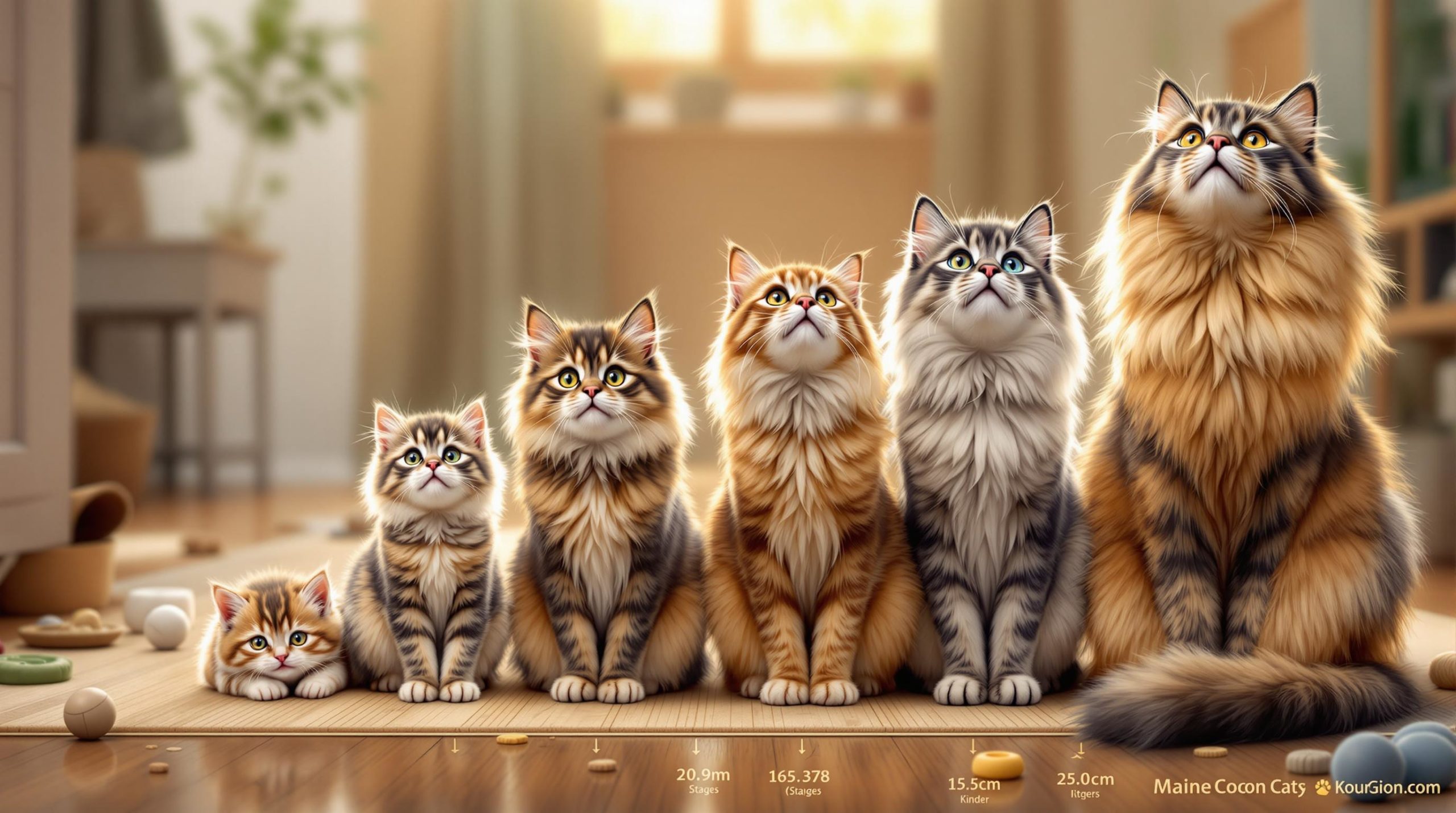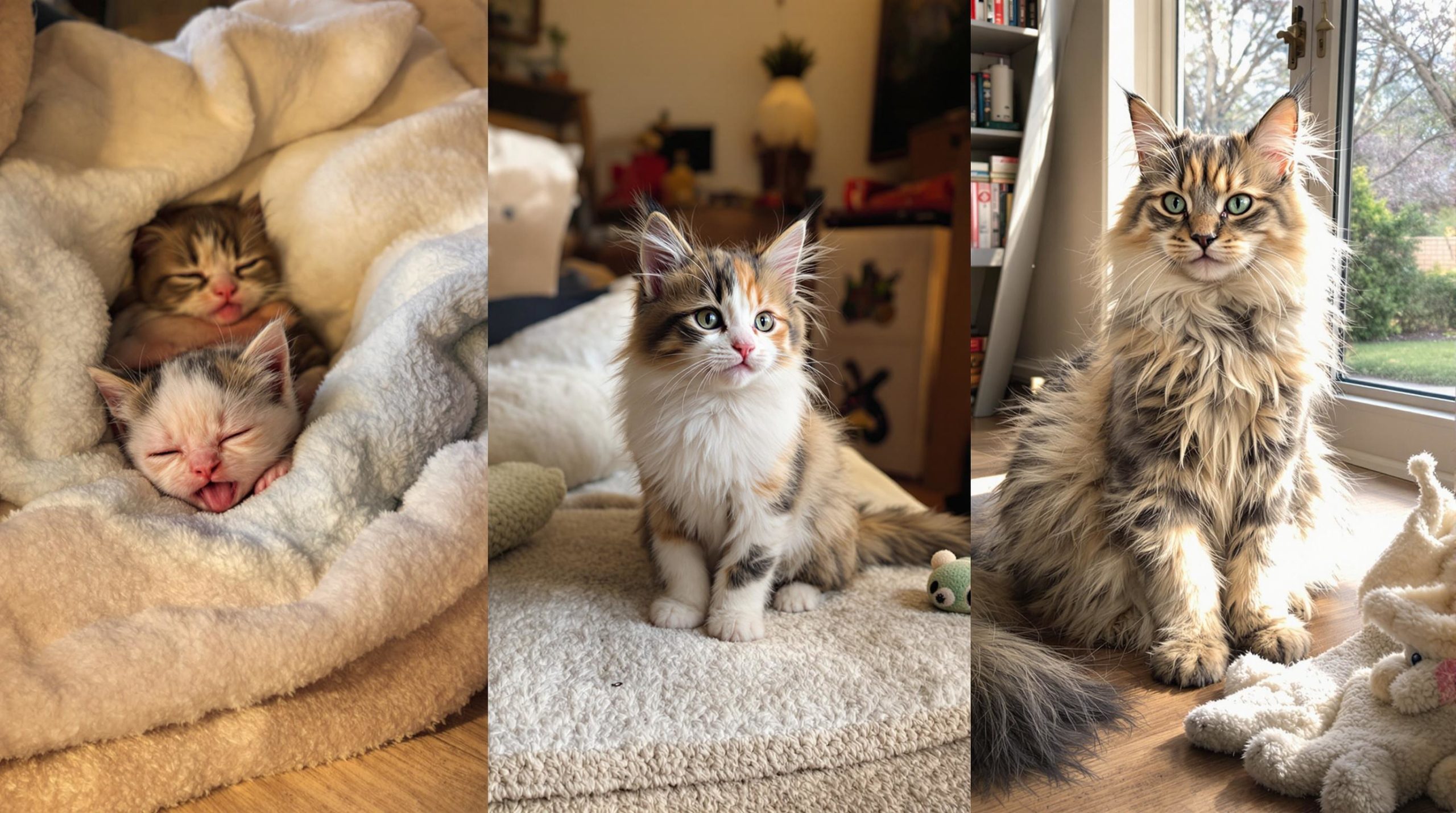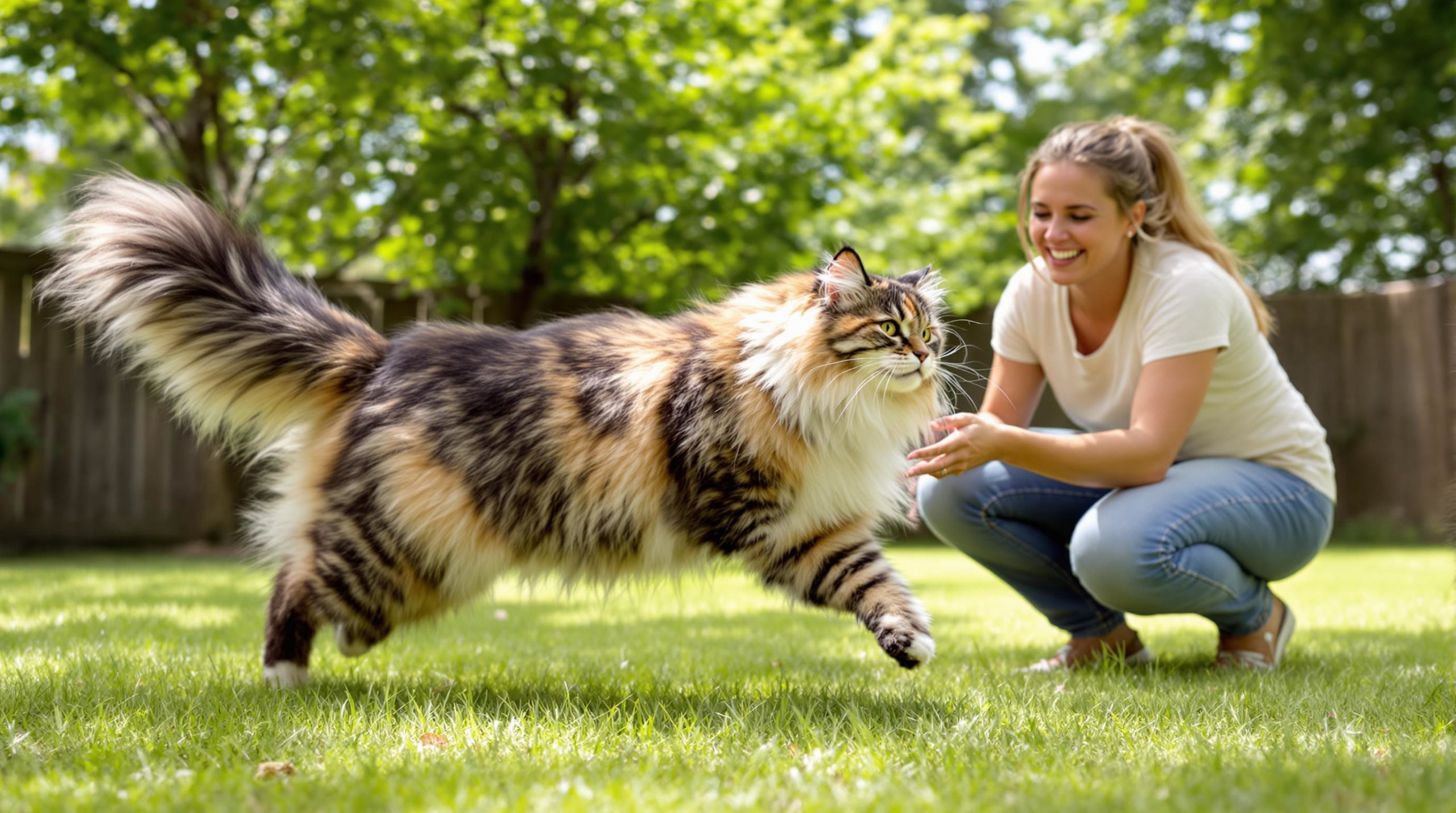Understanding the growth chart of Maine Coon cats

The majestic Maine Coon is recognized globally as one of the largest and most captivating cat breeds. With their impressive size reminiscent of small dogs and charming personalities that blend intelligence and affection, they have won the hearts of cat enthusiasts everywhere. Unlike typical cats, Maine Coons experience a notably extended growth timeline, gradually maturing over several years instead of months. Understanding the nuances behind this growth process is crucial for ensuring their health and happiness. Monitoring their development through a carefully maintained cat growth chart, alongside diligent attention to pet nutrition and veterinary care, sets the foundation for raising these gentle giants correctly. Through this guide, one can gain a comprehensive insight into the stages of Maine Coon growth, essential care tips, and factors influencing their development to thrive in loving homes and under the watchful eyes of responsible cat breeders.
Maine Coon Growth Chart: Tracking the Development of the World’s Second Largest Cat Breed
One of the most fascinating aspects of Maine Coon cats lies in their size. Standing as the second-largest breed worldwide, these cats often rival medium-sized dogs in both length and weight. Their physical growth unfolds much more slowly than many other breeds, which can often surprise new owners expecting a swift maturation process typical of most domestic cats.
Accurate tracking is made possible by using a Maine Coon specific cat growth chart, which provides benchmarks on weight, length, height, and tail measurements at various ages. This tool supports owners in ensuring the kitten is growing proportionally and healthily, avoiding common pitfalls like overfeeding or nutritional insufficiency. For professionals in feline genetics and veterinary care, these charts offer valuable insight into breed standards and developmental norms.
| Age | Male Weight | Female Weight | Length | Height | Tail Length |
|---|---|---|---|---|---|
| Newborn | 80-170 g (2.82-5.99 Oz) | 80-150 g (2.82-5.29 Oz) | ~18 inches (45 cm) | 6-9 inches (15-23 cm) | 11-15 inches (29-38 cm) |
| 1 Month | 610-820 g (21.51-28.92 Oz) | 560-740 g (19.75-26.10 Oz) | |||
| 6 Months | 5.5-6.1 kg (12.12-13.45 lbs) | 4.2-4.3 kg (9.26-9.48 lbs) | |||
| 1 Year | 8.1-9 kg (17.85-19.84 lbs) | 6.1-6.5 kg (13.45-14.33 lbs) | |||
| 5 Years | 9.1-11.3 kg (20-24.91 lbs) | 6.7-8.2 kg (14.77-18.07 lbs) |
Along with tracking physical metrics, owners should maintain detailed records of their Maine Coon’s nutritional intake and veterinary care schedule. Regular screening ensures that these giants develop without common health issues, such as hip dysplasia or heart conditions, which can be monitored with the support of cat health products and veterinary professionals specialized in large breeds.
Within specialized Maine Coon supplies, including adequate grooming tools tailored for their thick coats, lie key assistants in promoting comfort and cleanliness throughout their development. Implementing this all-encompassing monitoring strategy creates a proactive approach to their growth, catching irregularities early and fostering a robust feline companion.

Comparing Maine Coon Kitten Growth to Normal Cat Development
Maine Coon kittens present an extraordinary difference when compared to typical domestic cats. Their slow-developmental pace and larger dimensions make them a breed apart. As recorded in the Guinness Book of World Records, with a remarkable specimen named Stewie stretching 48.5 inches in length, they overshadow most other breeds in sheer size.
The divergent growth patterns are not merely physical but also behavioral and nutritional. Maine Coons receive focused care from dedicated cat breeders, which often includes customized pet nutrition plans, structured grooming sessions, and advanced socialization efforts that typical domestic cats frequently lack.
| Growth Feature | Maine Coon Kitten | Normal Kitten |
|---|---|---|
| Length | 18 inches (45 cm) | 15 inches (38 cm) |
| Weight at Birth | 150 g (5.50 Oz) | 100 g (3.50 Oz) |
| Height | 6-9 inches (15-23 cm) | 5-8 inches (13-20 cm) |
| Tail Length | 11-15 inches (29-38 cm) | 8.5-10 inches (22-25 cm) |
Several factors contribute to this growth disparity:
- Nutrition: Maine Coon kittens often benefit from a carefully planned diet, promoting optimal development over standard feeding routines.
- Grooming: Their long fur requires regular brushing and dental care, promoting better overall health from an early age.
- Training & Socialization: Maine Coons are known for their intelligence and quick learning abilities, thriving under attentive interaction and structured environments.
- Care Environment: Loving homes and knowledgeable breeders focus on environmental enrichment, ensuring proper physical and behavioral growth.
Additionally, owners who track their kittens’ growth through pet tracking apps find a clearer understanding of their development stages, enabling timely interventions when necessary. This level of detailed monitoring contributes significantly to the breed’s reputation for longevity and health.
Essential Growth Stages and How to Support Your Maine Coon’s Development
Understanding the developmental milestones of a Maine Coon cat is fundamental for nurturing their unique growth trajectory. Each stage—from newborn to mature adult—presents specific needs, challenges, and highlights that influence how well the cat thrives.
Newborn to Two Weeks: Fragile Beginnings
During the initial fortnight, Maine Coon kittens are extremely delicate and dependent. They cannot groom or feed themselves effectively, relying exclusively on maternal milk to meet nutritional requirements. It’s critical to provide a warm, secure environment with minimal disruptions to encourage healthy early development.
At this stage, feline genetics play a significant role, determining the natural baseline for growth, but the external environment undeniably impacts weight gain and immune health. Limited social interaction is advised to prevent stress.
Three to Eight Weeks: Exploration and Learning
Upon entering this active phase, kittens start to walk, play, and interact, signaling readiness for gradual introduction to solid foods. It’s a prime time for training and socialization, as Maine Coons absorb behavioral patterns and build trust with their human companions and other pets.
Parents and breeders should initiate grooming routines such as gentle brushing and tooth care. This stage shapes the basis for lifelong health and bonding.
Two to Four Months: Building Strength and Curiosity
With increasing physical ability, Maine Coon kittens exhibit a zest for exploration and require spaces that stimulate climbing and play. This age range is pivotal for establishing sociability to prevent adult fears or aggression. Well-structured feeding plans support steady weight gain aligned with the cat growth chart.
- Provide cat trees and toys to promote exercise
- Foster positive interactions with people and other animals
- Maintain consistent grooming to manage early coat growth
Five Months to One Year: Transition and Growth Slowdown
Growth metrics may experience a slowdown, but this is a period of significant behavioral development. Maine Coons demonstrate the emergence of emotions and attachment patterns akin to companion dogs.
Owners must maintain vigilance on pet nutrition, balancing calorie intake with physical activity to avoid unwanted weight gain. Veterinary care enhances monitoring of any health concerns that typically emerge as the cat matures.
| Age | Approximate Weight Range (kg) | Behavioral Development Notes |
|---|---|---|
| 0-2 weeks | 80-600g | Dependent, vulnerable to environment |
| 3-8 weeks | 610g-1.6kg | Socialization begins, teeth development |
| 2-4 months | 1.7-3.8 kg | Increased curiosity and motor skills |
| 5-12 months | 3.9-8 kg | Attachment formation & growth slows |
Integrating proper grooming and interactive playtime with Maine Coon supplies such as soft brushes and engaging toys enhances this stage. Moreover, owners should work closely with veterinary professionals to tailor immunization schedules and health check-ups carefully aligned with age milestones.

Boosting and Managing Growth Rates: Key Factors Impacting Maine Coon Development
Why do some Maine Coons grow faster or slower than others? The answer lies in a blend of genetics, environmental exposures, and human care. Both cat breeders and owners play decisive roles in modulating these factors to optimize the health and size of their Maine Coons.
Factors Accelerating Growth
- Genetics: Parental size and lineage heavily influence the growth potential.
- Nutrition: Balanced diets rich in proteins and vital nutrients, as prescribed by pet nutrition experts, enable robust development.
- Exercise: Regular physical activity, including climbing and interactive play, stimulates muscle growth and maintains healthy weight.
- Spaying/Neutering: Early procedures reduce energy spent on mating behavior, redirecting it to physical growth.
Factors That May Inhibit Growth
- Poor Diet: Insufficient or unbalanced nutrition directly impairs developmental progress.
- Neglected Grooming: Without proper hair and dental care, health can deteriorate, impacting growth negatively.
- Lack of Exercise: Sedentary lifestyles lead to suboptimal muscle development and potential obesity.
- Stress or Anxiety: Inadequate attention or social isolation can affect appetite and overall health adversely.
Combining an understanding of these causes with regular use of pet tracking apps provides owners with actionable insights. This holistic approach ensures that Maine Coon kittens remain on target within their anticipated development range reflected on the cat growth chart.

Long-Term Health and Care for Mature Maine Coons: Transitioning From Kitten to Adult
Maine Coons take their time to reach full maturity, often at 4 to 5 years of age, which necessitates continued care adjustments through their life stages. Transitioning from playful kittens to adult cats, their physical and behavioral needs evolve significantly.
Adult Maine Coons tend to reduce playtime and become less sociable but still require attention to their grooming regime to manage their thick fur, and adjustments in pet nutrition to prevent obesity and related illnesses. Regular veterinary care remains critical in middle and older age to address emerging health concerns prevalent in larger breeds.
This phase also benefits greatly from advances in cat health products formulated for mature felines and veterinary care appointments that focus on screening for diseases like hypertrophic cardiomyopathy and joint dysplasia.
| Age | Typical Weight | Key Care Focus |
|---|---|---|
| 1-5 Years | 8.1-11.3 kg (Male), 6.7-8.2 kg (Female) | Nutrition adjustment, grooming, behavioral changes |
| 6+ Years | Stable or slight decline in weight | Veterinary screenings, diet tailored to senior needs, enhanced grooming |
Owners who invest in Maine Coon supplies and adopt regular health monitoring set their pets on a course for longevity, surpassing 15 years in many cases under quality care. Observing changes through pet tracking apps and consulting with veterinary specialists enable timely interventions and extend the vitality of these remarkable cats.
FAQ About Maine Coon Growth and Care
- Q: When does a Maine Coon typically reach full adult size?
A: Unlike most cats, Maine Coons mature slowly and usually reach full size between 3 and 5 years of age. - Q: How important is nutrition in the growth of a Maine Coon?
A: Nutrition is crucial—balanced diets tailored by pet nutritionists help Maine Coons develop properly and maintain health throughout their long growth period. - Q: Can exercise really influence a Maine Coon’s growth?
A: Yes, active exercise encourages muscle development and overall well-being, which supports healthy growth and weight management. - Q: How can pet tracking apps help Maine Coon owners?
A: These apps help record growth data, feeding schedules, and health check-ups, improving owner awareness and early detection of health issues. - Q: Are grooming and veterinary care necessary throughout life stages?
A: Absolutely, consistent grooming reduces matting and health issues, while veterinary care ensures vaccinated, healthy cats, essential at every stage.